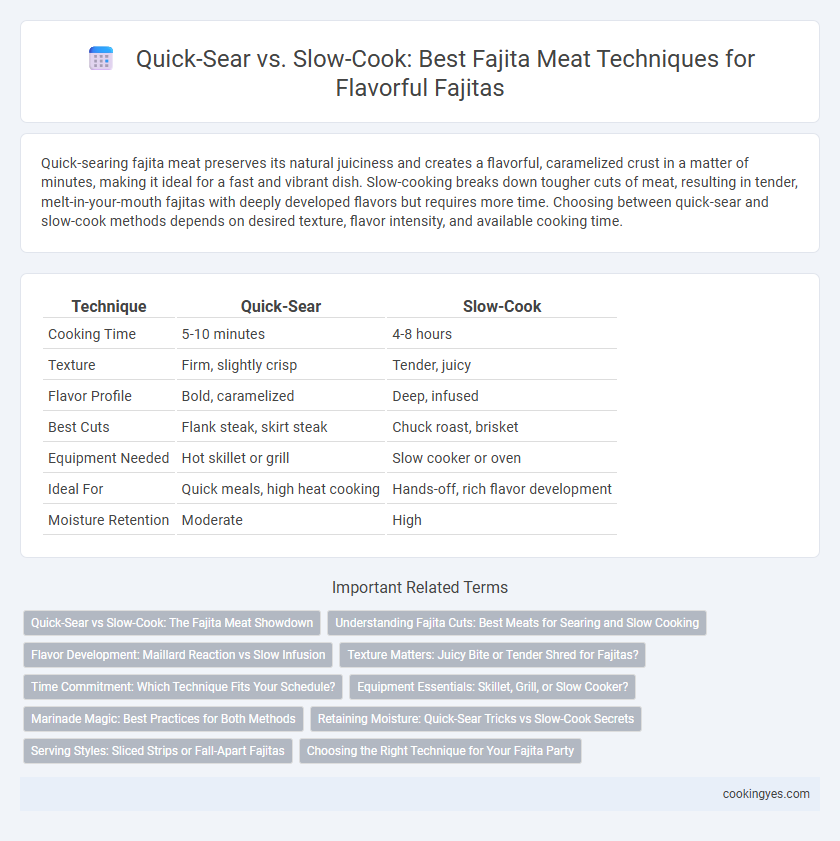Quick-searing fajita meat preserves its natural juiciness and creates a flavorful, caramelized crust in a matter of minutes, making it ideal for a fast and vibrant dish. Slow-cooking breaks down tougher cuts of meat, resulting in tender, melt-in-your-mouth fajitas with deeply developed flavors but requires more time. Choosing between quick-sear and slow-cook methods depends on desired texture, flavor intensity, and available cooking time.
Table of Comparison
| Technique | Quick-Sear | Slow-Cook |
|---|---|---|
| Cooking Time | 5-10 minutes | 4-8 hours |
| Texture | Firm, slightly crisp | Tender, juicy |
| Flavor Profile | Bold, caramelized | Deep, infused |
| Best Cuts | Flank steak, skirt steak | Chuck roast, brisket |
| Equipment Needed | Hot skillet or grill | Slow cooker or oven |
| Ideal For | Quick meals, high heat cooking | Hands-off, rich flavor development |
| Moisture Retention | Moderate | High |
Quick-Sear vs Slow-Cook: The Fajita Meat Showdown
Quick-sear fajita meat locks in juices and caramelizes the surface, enhancing flavor with a smoky char while preserving a tender, juicy interior. Slow-cook methods break down tougher cuts, resulting in melt-in-your-mouth texture but often lack the crisp char typical of traditional fajitas. Choosing between quick-sear and slow-cook depends on desired texture and flavor intensity, with quick-sear favored for authentic fajita crispness and slow-cook ideal for richer, more tender beef.
Understanding Fajita Cuts: Best Meats for Searing and Slow Cooking
Skirt steak and flank steak are ideal for quick-sear fajitas due to their thin, fibrous texture that benefits from high heat, preserving juiciness and flavor. For slow cooking, chuck roast and brisket cuts excel, allowing connective tissues to break down and resulting in tender, richly flavored meat. Selecting the right cut ensures optimal texture and enhances the savory profile in fajita preparations.
Flavor Development: Maillard Reaction vs Slow Infusion
Quick-searing fajita meat at high heat triggers the Maillard reaction, creating a flavorful crust with complex, savory notes. Slow-cooking allows the meat to absorb spices and seasonings deeply, resulting in tender texture and rich, infused flavors. Choosing between quick-sear and slow-cook methods impacts the intensity and layering of the fajita's taste profile.
Texture Matters: Juicy Bite or Tender Shred for Fajitas?
Quick-searing fajita meat at high heat locks in juices, delivering a juicy bite with a slightly crispy exterior, ideal for tender cuts like skirt or flank steak. Slow-cooking breaks down connective tissues over time, resulting in a tender shred perfect for tougher cuts or when aiming for a melt-in-your-mouth texture. Choosing between these methods impacts the fajita's overall mouthfeel, balancing between succulent firmness and soft tenderness.
Time Commitment: Which Technique Fits Your Schedule?
Quick-searing fajita meat takes just 5 to 10 minutes, making it ideal for weeknight meals and fast preparation. Slow-cooking requires 2 to 4 hours, perfect for meal prepping or weekend cooking when more time is available. Choosing between these methods depends on your available time and desired tenderness, as quick-sear preserves juiciness while slow-cook delivers melt-in-your-mouth texture.
Equipment Essentials: Skillet, Grill, or Slow Cooker?
Choosing the right equipment for cooking fajita meat significantly impacts flavor and texture. A cast-iron skillet or grill achieves a quick-sear with high direct heat, creating a caramelized crust while preserving juiciness. Conversely, a slow cooker gently breaks down tougher cuts over several hours, yielding tender, melt-in-mouth fajitas ideal for tougher meats like skirt or flank steak.
Marinade Magic: Best Practices for Both Methods
Marinating fajita meat enhances tenderness and infuses bold flavors that complement both quick-sear and slow-cook techniques. For quick-sear, use acidic marinades with lime juice, garlic, and chili powder for 30 minutes to break down proteins without overpowering the meat's natural texture. Slow-cook benefits from longer marination, up to 8 hours, with richer blends including cumin, onion, and coriander to deeply permeate fibers, ensuring succulent, flavorful results after hours of gentle heat.
Retaining Moisture: Quick-Sear Tricks vs Slow-Cook Secrets
Quick-searing fajita meat locks in juices rapidly by creating a caramelized crust that prevents moisture loss, resulting in tender and flavorful strips. Slow-cooking, on the other hand, allows collagen to break down over time, enhancing tenderness and retaining moisture through gentle heat and slow evaporation. Balancing high-heat quick-sear techniques with marinade acidity or controlled slow-cook environments ensures optimal moisture retention for juicy fajitas.
Serving Styles: Sliced Strips or Fall-Apart Fajitas
Quick-sear fajita meat is ideal for serving as sliced strips, highlighting a tender yet firm texture that retains juiciness and pairs perfectly with fresh tortillas and crisp vegetables. Slow-cooked fajitas result in fall-apart meat, offering a rich, deeply marinated flavor ideal for casual serving styles where meat can be shredded and piled generously. Both techniques emphasize different serving experiences: quick-sear caters to a refined presentation with distinct cuts, while slow-cook supports a hearty, rustic style with melt-in-your-mouth tenderness.
Choosing the Right Technique for Your Fajita Party
Quick-searing fajita meat retains tender juiciness and creates a flavorful crust ideal for fast cooking over high heat, perfect for busy fajita parties. Slow-cooking breaks down tougher cuts, enhancing tenderness and infusing deep flavors, ideal for a relaxed, smoky fajita experience. Selecting the right technique depends on time constraints, desired texture, and meat cut to deliver the best fajita flavor and presentation.
Quick-sear vs Slow-cook for fajita meat technique Infographic

 cookingyes.com
cookingyes.com